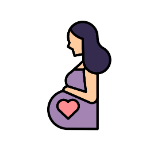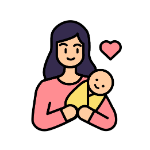
Childcare
Babywearing 101: The Benefits And Techniques Of Carrying Your Little One
6 min | Updated on 31-07-2023 by HappyPreggie
(Image credits to The Bump)
Are you a new parent seeking a way to keep your little one close and secure while tending to your daily tasks? Or perhaps you're an experienced caregiver looking for ways to enhance your baby's development while fostering a strong bond? Look no further - in this blog, we'll dive into the world of carrying your newborn with confidence and discover the numerous benefits it brings. From promoting healthy hip development to creating an intimate connection between parent and baby, babywearing has become an essential practice cherished by parents worldwide. Let's explore the art of babywearing, learn various techniques, and empower you with the knowledge and skills to make babywearing a rewarding experience for both you and your little one!
What Are The Benefits Of Babywearing?
- Babywearing fosters a deep sense of bonding between parent and baby through close physical contact, which creates a secure and loving environment.
- Babywearing helps regulate the baby's body temperature and breathing, especially during the early months when they struggle to maintain their body heat independently.
- Babywearing exposes the baby to a stimulating sensory experience at the adult's eye level, enhancing cognitive development and curiosity.
- Babywearing has been shown to soothe colicky babies and reduce crying episodes, as it offers continuous motion and reassurance.
- Baby carriers provide parents with the freedom to carry out daily tasks while keeping their baby close and content, offering a convenient, hands-free parenting solution.
Choosing the Right Baby Carrier
Baby carriers come in various styles, each offering different features and benefits to suit the needs and preferences of parents and caregivers. Here are some of the baby carrier types you can find in the market:
#1 Ring Slings
(Image credits to Baby Tula Eu)
Ring slings consist of a long piece of fabric with two rings attached at one end. The fabric is threaded through the rings to create a loop, allowing for easy adjustability. They are quick and ideal for newborns, offering a cosy feel and discreet breastfeeding.
#2 Wraps
(Image credits to The Baby Carrier Shop)
Wraps are long, stretchy or woven pieces of fabric tied around the caregiver's body. They are versatile, suitable for newborns to toddlers, and provide excellent support for the baby's head, neck, and spine.
#3 Soft-Structured Carriers (SSCs)
(Image credits to The Sleep Store)
SSCs are structured carriers with padded straps and a waistband. They evenly distribute the baby's weight for comfort during extended wear and offer various carrying positions.
#4 Mei Tais
(Image credits to Etsy)
Mei Tais combines wrap and SSC features with a rectangular body panel and long straps tied around the parent's body. They are easy to use, customisable, and suitable for newborns till toddlers.
Factors To Consider When Choosing A Baby Carrier
- Age and Size: Choose a carrier suitable for your baby's age and size to provide proper support.
- Comfort and Fit: Look for carriers with padded straps for comfort during extended use.
- Carrying Positions: Select a carrier that supports your preferred carrying positions (front, back, or hip).
- Ease of Use: Opt for a carrier with quick and intuitive adjustments for convenience.
- Safety Guidelines: Follow manufacturer's safety guidelines to ensure proper positioning and prevent dislocated hips.
- Fabric and Cleaning: Consider machine-washable carriers for easy maintenance.
- Baby's Comfort: Ensure the baby's chin is off their chest and knees higher than their bottom for comfort and support.
Babywearing Techniques
a. Front Carry - Newborn Hold
(Image credits to The Amazon UK)
- Place the carrier of your choice over one shoulder with the fabric panel centred on your chest.
- Hold your baby securely in one arm and carefully lower them into the carrier with their head facing inward.
- Use your free hand to support the baby's bottom and guide their legs into a "froggy" or "M" position, with their knees higher than their bottom and their hips spread comfortably.
- Adjust the carrier's fabric to support the baby's head and neck while ensuring there is no fabric covering their face or airways.
- Securely fasten the carrier and make any necessary adjustments for a snug fit.
b. Hip Carry
(Image credits to Beco Baby Carriers)
- Position the carrier on your hip with the fabric panel centred on your side.
- Hold your baby securely against your chest with one arm and lower them into the carrier, ensuring their legs are positioned in the "M" shape.
- Use your free hand to support their bottom and guide their legs into the carrier.
- Adjust the carrier to support their head and neck, making sure their face is visible and clear of fabric.
- Securely fasten the carrier and check for a snug fit.
c. Back Carry (for older babies)
(Image credits to Tula Baby Carrier)
- Position the carrier on your front as if for a front carry, but slightly lower than usual.
- Securely hold your baby in one arm and carefully move them to your back, supporting their head and neck throughout.
- Hold the baby with one hand while using the other to pull the carrier up and over their back.
- Position the baby in an upright, seated position with their knees higher than their bottom, and their hips spread comfortably.
- Securely fasten the carrier and check for proper support of the baby's head and neck.
Importance Of Proper Babywearing
- Proper ergonomics position evenly distributes your baby's weight, which prevents discomfort during babywearing while also minimising the risk of muscle strains and joint issues for frequent users or those with pre-existing conditions.
- Well-fitted carriers encourage upright posture, supporting spine alignment, reducing back and neck strain, and offering ample support for your baby's spine, maintaining its natural curvature and alignment.
- Additionally, well-designed carriers position the baby's hips in the "M" shape, promoting healthy hip development, while ensuring the baby's chin remains off their chest and airways clear to prevent suffocation and breathing difficulties during babywearing.
Common Challenges Of Babywearing
- What do I do if my baby refuses to be carried?
- How can I ensure my baby’s utmost comfort?
- Will my baby get overheated during hot weather?
Safety Precautions for Babywearing
Ensuring a safe babywearing experience is essential for the well-being of both the parent and the baby. By following these safety guidelines, you can create a secure and comfortable environment for your little one:
- Keep the baby in an ergonomic "M" or "froggy" position with clear airways and their chin up to facilitate unobstructed breathing.
- Adhere to the manufacturer's guidelines for age and weight limits of the carrier to ensure it is suitable for your baby's developmental stage.
- Regularly check for wear, tear, and damaged parts to ensure a secure hold and prevent any potential accidents.
- Ensure the carrier fits snugly and is properly fastened to prevent discomfort and ensure the baby's safety.
- Provide extra head and neck support for newborns and young babies due to their developing muscles.
- Avoid engaging in activities that may compromise the baby's safety while in the carrier, such as cooking over an open flame or participating in contact sports.
- Refrain from wearing your baby on high surfaces like countertops, beds, or sofas to prevent the risk of serious injuries from falls.
- Be mindful of older siblings or pets when babywearing to prevent accidental knocks or interference that may affect the baby's safety.
- Always be aware of your surroundings and potential hazards, especially in crowded or busy environments, to ensure a safe babywearing experience.
The benefits of babywearing go far beyond convenience, as it nurtures a profound connection between you and your little one. From promoting healthy development and reducing fussiness to offering hands-free convenience, babywearing is truly a cherished tradition with a place in modern parenting. As you embark on this beautiful journey, remember to prioritise safety, follow proper techniques, and trust your instincts. Embrace the magic of babywearing, creating treasured memories that will stay with you and your baby for a lifetime!
Check out our blog to find the ideal baby carrier for you and your little one!
Join the largest support network for family health and well-being. Ready to get started?
Get started
















